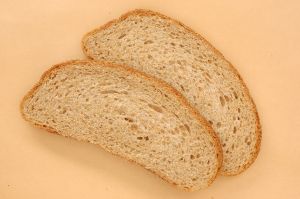By Jenna Shaw Have you ever heard of Locust Bean Gum before? How about Guar Gum? If you are new to the gluten-free lifestyle and looking for more information on stabilising agents to use in baking, then you will want to read this article. This article will cover 3 of the most common binders that are used in gluten free products. You will find the binders used in many types of food found in your kitchen from salad dressings to ice cream. Binders (emulsifiers) help to keep the contents of a mixture together and can help the ingredients in your baking mixer from separating and falling apart. There are many different binders available on the market which are derived from different ingredients and manufacturing processes. People with allergies to specific food products need to be aware of the contents that the gum product may contain. The 3 main binders used in the gluten-free industry are Guar Gum, Locust Bean Gum and Xanthan Gum Guar gum is a binder that is produced from natural guar beans in the form of a fine white powder. This gum has about eight times the power of ordinary cornstarch with less sugars and is one of the most frequently used gums in gluten-free products. It is a very economical gum which can replace up to 10 times the amount of flour in most baking products. Guar gum mixes easily in water and does not require heating which will suit different baking requirements. If you are new to the gluten-free diet, then you should be able to consume any food that contains guar gum. Guar gum has a high content of fibre without the gluten, however consuming over the recommended daily intake can lead to diarrhoea and stomach problems. Guar Gum has also been used in diet industry when wanting to limit calorie intake as the gum can help to delay the breakdown of food in the stomach. A slower breakdown of food will make you feel fuller for longer. Locust Bean Gum is a stabilising agent that is extracted from the seeds of the Carob Tree and is also know as Carob Gum. The gum is produced mainly in the Mediterranean region and is produced in the form of a white powder. The powder is odourless and has a very bland taste making it ideal when you need to add a tasteless binder to you baking mix. Locust Bean Gum has many other uses other than food and is often found in products such as tobacco, textile and manufacturing, cosmetics and pet food. Locust Bean powder has a taste similar to cocoa and contains less fat, less calories and provides more fiber content. The gum is a great substitute sweetener used in the food industry and can be used as a substitute for chocolate in many baking recipes. Xanthan gum is a product derived from the fermentation of corn, wheat and even soy. It is used as a binding agent in a wide variety of products from food to personal care products. Xanthan Gum is used in a variety of foods from salad dressings, frozen foods, beverages, egg substitutes, ice cream and flour based food products. Xanthan gum is also widely used in the cosmetic industry, where the additive thickens face creams and acts as a binding agent to ensure product consistency. People with allergies to corn, wheat or soy may need to use a substitute for xanthan gum as the gum could contain traces. There are many available substitutes for Xanthan Gum on the market for you to try the next time you feel like baking. Which gum do you prefer – Xanthan Gum, Locust Bean Gum or Guar Gum? Leave us a comment below and share your experience. If you are looking for more information on Xanthan Gum Substitutes then read this post.
Guar Gum, Locust Bean Gum and Xanthan Gum
Guar Gum
Locust Bean Gum
Xanthan Gum
Guar Gum, Locust Bean Gum of Xanthan Gum?
By Jenna Shaw If you are currently on a gluten-free diet, then you should be able to consume any food that contains guar gum. It has a high content of fibre without the gluten, however too much can lead to diarrhoea or gas side effects so be wise when consuming too much. The gum can also be used when wanting to limit calorie intake to lose weight as it has properties that can delay the breakdown of food in the stomach and make you feel full longer. A healthy diet includes exercise and proper nutrition. India is the largest producer and trader of Guar in the world, producing roughly 600,000 tons a year. Other major produces are the United States, France, Italy, Japan, United Kingdom and South Africa. Guar Gum has many other uses than food as you will find it used in mining, cosmetics, oil and gas drilling, pet food, fire retardant and paper and textile manufacturing. You can find out more information on Locust Bean Gum here. Author: Jenna
What is Guar Gum?
Guar Gum is a binder/thickener that comes from guar beans in the form of a white powder. It has about eight times the thickening power of cornstarch without the starch sugars and is one of the most frequently used gums in gluten-free products. It is very economical as it can replace up to 10 times the amount of flour in most baking products. It mixes easily in water and does not require heating.Guar Gum Producers
Guar Gum used in the Kitchen
 When comparing Xanthan Gum versus Guar Gum used in the kitchen, we have found that Xanthan Gum works best when baking breads while the other is best used in cold foods like ice cream. There is no hard set rule about using both in a recipe however if you are allergic to Guar Gum then you might want to try using Xanthan Gum, Locust Bean Gum or one of the many Xanthan Gum Substitutes listed here.
When comparing Xanthan Gum versus Guar Gum used in the kitchen, we have found that Xanthan Gum works best when baking breads while the other is best used in cold foods like ice cream. There is no hard set rule about using both in a recipe however if you are allergic to Guar Gum then you might want to try using Xanthan Gum, Locust Bean Gum or one of the many Xanthan Gum Substitutes listed here.
By Jenna Shaw Locust Bean powder has a similar taste to cocoa powder and contains less fat, less calories and provides more fiber. When used in food it is a great substitute sweetener and can be substituted for chocolate. It has been used in salad dressings, ice cream, cheese, mayonnaise, tomato catsup, fruit juice, bread pie, filling and syrups. It is used in ice cream to prevent ice crystals from forming and give more texture. We have found that when using the gum to bake cookies, the gum gives the cookies a nice crunchy texture, gives a nice sweet buttery taste and seems to round out the overall taste. When baking cakes in the kitchen we noticed that we could use less eggs and using the gum resulted in a firmer textured cake that was more easily cut. The cake was also really easy to remove from the baking pan. There are many benefits to using the gum and it is a safe, healthy and cost effective substitute to Xanthan Gum. There are many places to purchase the gum. If you are interested in locating a local supplier than keep tuned into this blog as we will be posting a list of the best suppliers available very soon. If you or someone in your family has a gluten problem then why not try out the substitute in your next baking experience and drop us a comment below to let us know how you get on. Author: Jenna
Locust Bean Gum
 Locust Bean Gum is a cost effective vegetable gum extracted from the seeds of a Carob Tree and is also know as Carob Gum, located mostly in the Mediterranean region. It is used as a stabiliser and thickening agent like Xanthan Gum and comes in the form of a white/yellow powder. The powder is odourless and has a very bland taste. Locust Bean Gum has many uses and is also used in non food products such as tobacco, textile and manufacturing, cosmetics and pet food.
Locust Bean Gum is a cost effective vegetable gum extracted from the seeds of a Carob Tree and is also know as Carob Gum, located mostly in the Mediterranean region. It is used as a stabiliser and thickening agent like Xanthan Gum and comes in the form of a white/yellow powder. The powder is odourless and has a very bland taste. Locust Bean Gum has many uses and is also used in non food products such as tobacco, textile and manufacturing, cosmetics and pet food.Locust Bean Gum in the Kitchen
Benefits of Locust Bean Gum
Side Effects of Locust Bean Gum
By Jenna Shaw Xanthan Gum is a food thickener / stabilizing agent used to bind food together read more about it here. It can be used as a laxative for constipation, however if too much is consumed then side effects such as bloating and intestinal problems can occur. The World Health Organization (WHO) have recommended the following daily intakes: When used as a Food Additive: 10 mg/kg When used as a Laxative: 15mg It is best to read the labels on foods and take note of how much you are consuming to avoid some of the typical side effects that can occur. If the food packaging does not contain the information then you may have to contact the manufacturer and ask them directly. As consumers we have a right to know what is contained in the foods we purchase. If you have an allergy to corn, soy or wheat then you may want to seek an alternative stabilizing agent. Also if you are currently pregnant or breast feeding then it is best to stay on the safe side and avoid consuming a large amount of the gum as there have not been enough tests completed to verify the safety of consuming while pregnant or breast feeding. Please contact your doctor or health professional for more information. If you have a known allergy to xanthan gum then you should check out our article on the many Xanthan Gum Substitutes available. Author: Jenna
The Most Common Xanthan Gum Side Effects
 Xanthan Gum is safe if used in moderate amounts, however if you have a know allergy or have consumed a large amount of the gum then side effects can occur. This article covers some of the most common side effects that can occur.
Xanthan Gum is safe if used in moderate amounts, however if you have a know allergy or have consumed a large amount of the gum then side effects can occur. This article covers some of the most common side effects that can occur.The Most Common Xanthan Gum Side Effects
Xanthan Gum Side Effects Summary
By Jenna Shaw One of the main differences between the two are the way they are made. XG is derived from the fermentation of corn, wheat or soy and made from many sugars. GG is made from natural guar beans native to Asia and comes in the form of a white fine powder. When comparing the two we came across a list of key points for each: In conclusion we have found that both products work well in different situations. When we made ice cream we preferred using Guar Gum as it prevented ice crystal from forming, when making bread or sauces we preferred Xanthan Gum as the sauces were thicker and the texture and taste of the bread was more like gluten. Guar Gum tended to produce a more grainier texture with less taste. If you do not have a preference for one over the other than both can be used together to combine the thickening properties. Guar gum is less expensive so why not try it out or one of the many Xanthan Gum Substitutes listed here. Author: Jenna
What is the difference between Xanthan Gum and Guar Gum?
 Both Xanthan Gum (XG) and Guar Gum (GG) are the most frequently used products in gluten-free recipes and products and they both act as a thickener/stabiliser to help your baking mix stick together for a better result. Both products are used in gluten-free products so which one is better? Does one have an advantage over the other?
Both Xanthan Gum (XG) and Guar Gum (GG) are the most frequently used products in gluten-free recipes and products and they both act as a thickener/stabiliser to help your baking mix stick together for a better result. Both products are used in gluten-free products so which one is better? Does one have an advantage over the other?Xanthan Gum and Guar Gum Comparison?
Xanthan Gum vs Guar Gum Conclusion
By Jenna Shaw Xanthan Gum (XG) is a carbohydrate that is made from several sugars, it is produced from the fermentation of bacteria. It is used as a thickener and stabilizer in many processed foods that range from salad dressings to baked goods. For example XG keeps the oil contents of salad dressing together from separating and floating. In egg white substitutes it keeps the egg whites together and takes over the job of the yolk binding the contents together. In ice cream it prevents the formation of ice crystals ensuring that the ice cream remains smooth, rich and creamy. Xanthan Gum can be derived from corn, wheat or soy, so unless you know exactly where your source of XG is coming from then you want to avoid it if you are allergic to gluten and living a gluten-free lifestyle as it may contain traces of gluten. Contact the manufacture of the product or check out their website for more information on the source of the XG before consuming. As a consumer you have the right to know what you are consuming, so take some time and do some research. From our experience we have noticed people’s migraines stopped after consuming XG and their digestive tract improve. XG is a food additive and is safe if used in moderate amounts, assuming you are not allergic to it. It is a form of fiber and some people could find it indigestible. If you are allergic to gluten then be cautious and avoid xanthan gum as it could be derived from corn. We would not recommend XG if you are pregnant, breast feeding, have bowel problems or have intestine pain. A good substitute to try would be Locust Bean Gum or Guar Gum. Visit our Xanthan Gum Substitute page for a list of substitutes to try and enjoy your healthy lifestyle. Author: Jenna
Is Xanthan Gum Safe?
What is in Xanthan Gum?
So is Xanthan Gum Safe?





